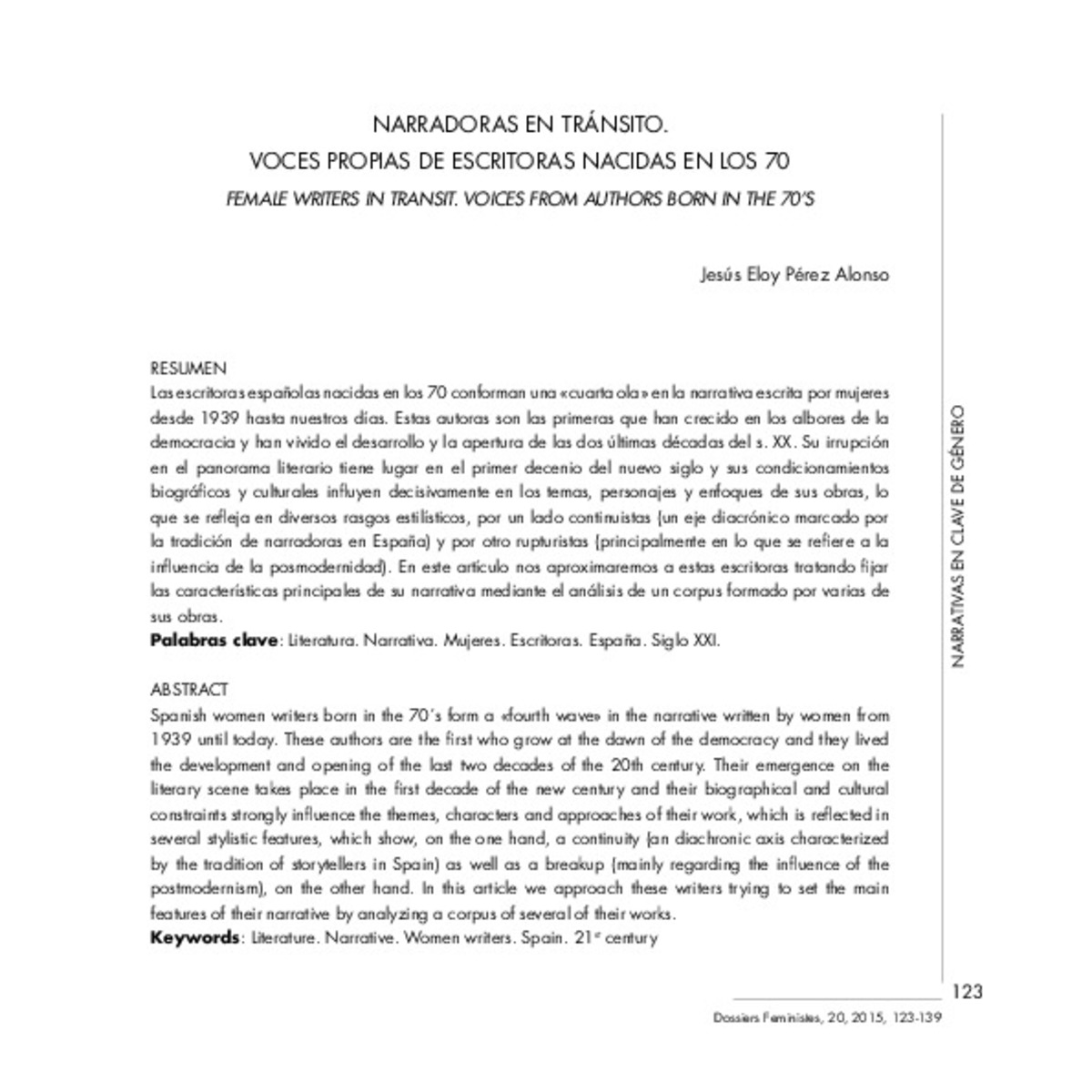Mostrar el registro sencillo del ítem
Narradoras en tránsito. Voces propias de escritoras nacidas en los 70
| dc.contributor.author | Pérez Alonso, Jesús Eloy | |
| dc.date.accessioned | 2017-02-28T13:45:02Z | |
| dc.date.available | 2017-02-28T13:45:02Z | |
| dc.date.issued | 2015 | |
| dc.identifier.citation | PÉREZ ALONSO, Jesús Eloy. Narradoras en tránsito. Voces propias de escritoras nacidas en los 70. Dossiers feministes, 2015, no 20, p. 123-139. | ca_CA |
| dc.identifier.issn | 1139-1219 | |
| dc.identifier.issn | 2340-4930 | |
| dc.identifier.uri | http://hdl.handle.net/10234/166344 | |
| dc.description.abstract | Spanish women writers born in the 70´s form a «fourth wave» in the narrative written by women from 1939 until today. These authors are the first who grow at the dawn of the democracy and they lived the development and opening of the last two decades of the 20th century. Their emergence on the literary scene takes place in the first decade of the new century and their biographical and cultural constraints strongly influence the themes, characters and approaches of their work, which is reflected in several stylistic features, which show, on the one hand, a continuity (an diachronic axis characterized by the tradition of storytellers in Spain) as well as a breakup (mainly regarding the influence of the postmodernism), on the other hand. In this article we approach these writers trying to set the main features of their narrative by analyzing a corpus of several of their works. | ca_CA |
| dc.description.abstract | Las escritoras españolas nacidas en los 70 conforman una “cuarta ola” en la narrativa escrita por mujeres desde 1939 hasta nuestros días. Estas autoras son las primeras que han crecido en los albores de la democracia y han vivido el desarrollo y la apertura de las dos últimas décadas del s. XX. Su irrupción en el panorama literario tiene lugar en el primer decenio del nuevo siglo y sus condicionamientos biográficos y culturales influyen decisivamente en los temas, personajes y enfoques de sus obras, lo que se refleja en diversos rasgos estilísticos, por un lado continuistas (un eje diacrónico marcado por la tradición de narradoras en España) y por otro rupturistas (principalmente en lo que se refiere a la influencia de la posmodernidad). En este artículo nos aproximaremos a estas escritoras tratando fijar las características principales de su narrativa mediante el análisis de un corpus formado por varias de sus obras. | ca_CA |
| dc.format.extent | 17 p. | ca_CA |
| dc.format.mimetype | application/pdf | ca_CA |
| dc.language.iso | spa | ca_CA |
| dc.publisher | Universitat Jaume I. Institut Universitari d'Estudis Feministes i de Gènere | ca_CA |
| dc.relation.isPartOf | Dossiers feministes, 2015, no. 20 | ca_CA |
| dc.rights.uri | http://rightsstatements.org/vocab/CNE/1.0/ | * |
| dc.subject | literatura | ca_CA |
| dc.subject | narrativa | ca_CA |
| dc.subject | mujeres | ca_CA |
| dc.subject | escritoras | ca_CA |
| dc.subject | España | ca_CA |
| dc.subject | siglo XXI | ca_CA |
| dc.subject | literature | ca_CA |
| dc.subject | narrative | ca_CA |
| dc.subject | women writers | ca_CA |
| dc.subject | Spain | ca_CA |
| dc.subject | 21st century | ca_CA |
| dc.title | Narradoras en tránsito. Voces propias de escritoras nacidas en los 70 | ca_CA |
| dc.title.alternative | Female writers in transit: voices from authors born in the 70’s | ca_CA |
| dc.type | info:eu-repo/semantics/article | ca_CA |
| dc.rights.accessRights | info:eu-repo/semantics/openAccess | ca_CA |
| dc.relation.publisherVersion | http://www.e-revistes.uji.es/index.php/dossiers/article/view/1763/1802 | ca_CA |







